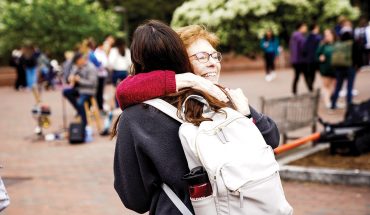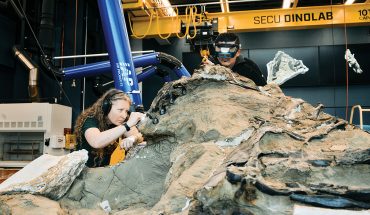Founded by Amber Smith, Activate Good uses its database to find volunteer opportunities based on skill set, interest and available time.
by Catherine Currin | photograph courtesy Activate Good
Amber Smith has always felt called to do more. While she was in college at North Carolina State University, she’d volunteer with all sorts of causes. “Everything from marketing to combat youth homelessness to serving meals at the men’s shelter,” she says. “Any kind of volunteering you could think of.”
Smith felt so compelled to do good, in fact, that she paused her schooling after her sophomore year to do it full-time. She enlisted her best friend from high school, Heather Leah, who quit her job, and the two dreamed up how they could amplify their impact in their own community and beyond. In the fall of 2004, the pair traveled on their own for two and a half months to 20 states to volunteer and “do some good.” “We stayed with friends, family and even some strangers along the way,” says Smith. “We traveled until we went completely broke.”
The duo made it back to Raleigh, but continued to be inspired by what they saw on their road trip. “Everywhere we volunteered, the folks working at the nonprofits had emphasized the huge value of people giving their time and talents. Many nonprofits are constantly strapped for resources and rely on volunteers to make an impact,” says Smith. She would ask people on their travels, “Why do you or don’t you volunteer?” She found that almost everyone felt called to give back, but for the ones who didn’t manage to, the answer was often, “I want to, but I don’t know where to start.” “We realized everyday people crave making a difference,” she says. So Smith and Leah decided to work to create the missing piece of the puzzle: bridging the gap between organizations in need of volunteers and community members who were looking for an opportunity to give back.
“We found that the needs are so overwhelming, it’s mind-boggling.” Smith says. “It’s hard to identify what the needs are.” One of the biggest hurdles for many people was not knowing how to look for a cause they’d be passionate about volunteering for. “We wanted to launch a nonprofit that would connect people to a cause where they could make an impact.”
The two founded Activate Good in 2005 as a way to do just that. Here’s how it works: nonprofit organizations opt in to Activate Good as a community partner, and potential volunteers can search its extensive database for opportunities (say, sorting clothing at Note in the Pocket to working in the garden at Inter-Faith Food Shuttle). On its website, you can browse by skill set or interest to find the right opportunity. This matchmaking process emphasizes high-impact projects where people can best use their specific time and talents. Activate Good believes there’s something for everyone. That includes options for individuals, families with kids and even large groups.
Thomas Hogshead, the volunteer coordinator at Healing Transitions, has worked with Activate Good to coordinate an annual day of service for September 11. Through their program, a team of ten toured the campus off Lake Wheeler Road, had lunch with participants and mulched the garden on the Healing Transitions grounds. This single day of service has been a success annually for Activate Good since 2012, and this year Smith plans to expand it to an entire month of service. “There’s no one-size-fits-all opportunity for someone to volunteer or donate,” says Smith. “We really excel at bringing people together, no matter the background. We’re improving the community together.”
Note in the Pocket’s executive director Dallas Bonavita has been working with Activate Good since 2013. “True story, the first volunteer who found us through AG is still actively volunteering with us after seven years and is an important part of our organizational family,” says Bonavita. “We have established long-term relationships with so many amazing people who found us this same way.
“They are master connectors!” Maggie Kane, executive director of pay-what-you-can cafe A Place at the Table, agrees. “Through AG, we have found some incredible volunteers that are a major part of our mission every day. I could not recommend them more.”
Leah left the nonprofit in 2006 to pursue a career in broadcast journalism; Smith continues to serve as the executive director (she eventually completed her undergraduate degree and earned a master’s degree in nonprofit management, as well). Smith works alongside six staff members in Dock 2053’s Loading Dock space. She credits much of the growth at Activate Good to a growing use of technology and advancements to streamline the process. She says the website was just the beginning of the community Activate Good was creating. “We realized when you’re trying to inspire people to get involved in the community, a website is a tool to facilitate, but it doesn’t build community,” Smith says. That’s why in March, Smith launched The Good Hub, a pop-up pilot of a community space, located off of Oberlin Road.
Due to COVID-19, the space closed a week after opening; Smith hopes to relaunch in the near future with workshops, a kid’s zone and more. But the core of Activate Good’s mission remained the same—and kept working. “We pivoted very fast when COVID hit. We had to adapt to figure out how people could volunteer remotely from home and how we could continue to get volunteers who were healthy and comfortable to meet urgent, in-person needs,” says Smith. One example: Activate Good partnered with Wake County Public Schools to configure over 10,000 WiFi hotspots to aid in digital learning. “Wake County didn’t have the people power to get them configured quickly—it would’ve taken a couple of months,” says Smith. “We recruited over 200 volunteers in a socially-distanced environment and configured the hotspots in just four days.”
Today, you can find opportunities like virtual grant-writing or creating school packets for kids who need extra help over the summer. Smith says that she saw early on how impactful these remote opportunities were during the pandemic. “People needed something in the chaos. We saw that volunteering was giving people an opportunity to use time to make someone else’s life better. It helped them get through the day, too.”
Smith believes that we all have a responsibility to work to improve the world, and that most everyone will want to be a part of it. “When you can tell the story of the impact being made, you are hard-pressed to find someone who doesn’t want to help the community.”




